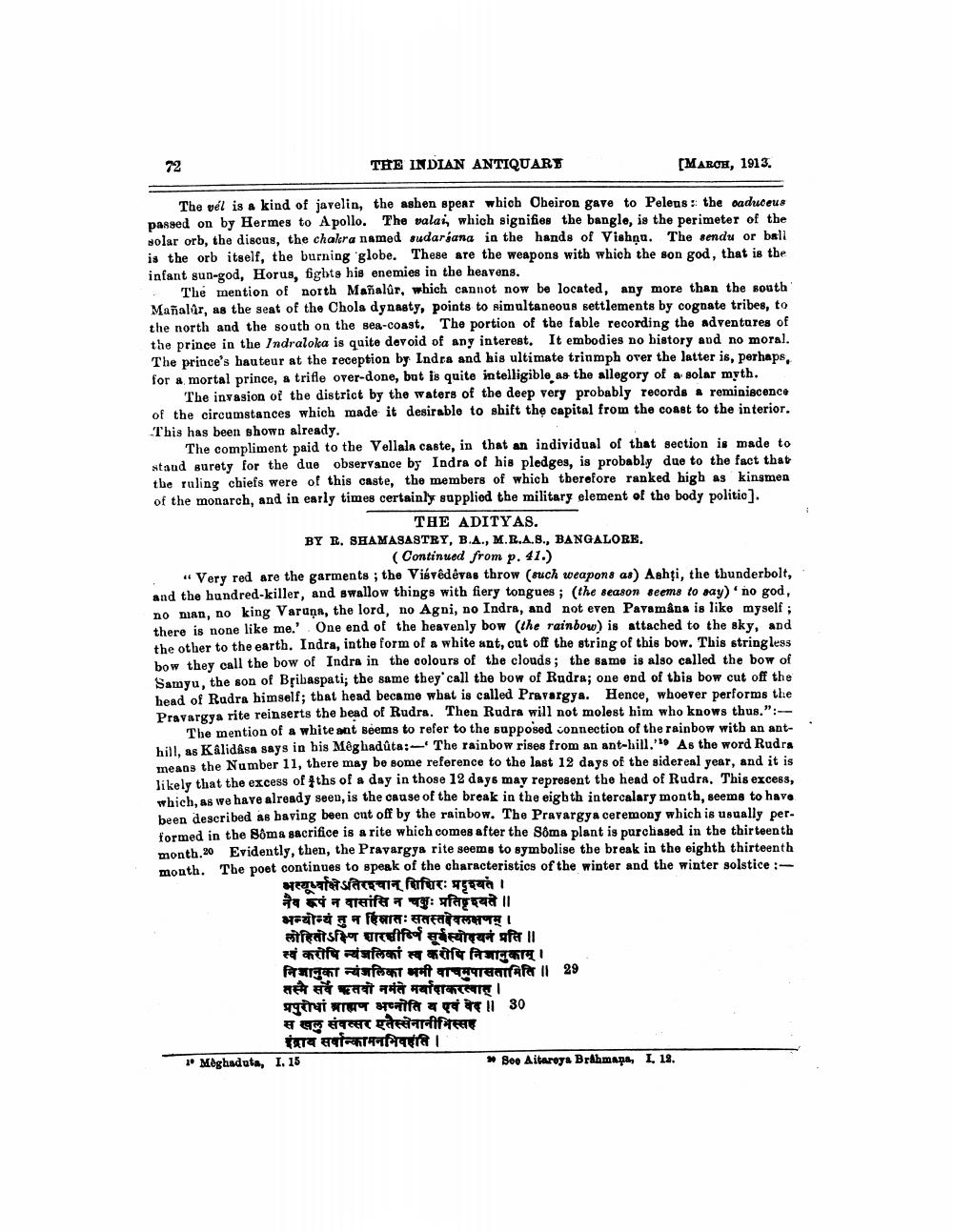________________
72
THE INDIAN ANTIQUART
[MAROH, 1913.
The vél is a kind of javelin, the ashen spear which Oheiron gave to Peleus: the oaduceus passed on by Hermes to Apollo. The valai, which signifies the banglo, is the perimeter of the solar orb, the discus, the chalera named sudarsana in the hands of Vishņu. The sendu or ball is the orb itself, the burning globe. These are the weapons with which the son god, that is the infant sun-god, Horus, fights his enemies in the heavens.
The mention of north Mañalûr, which cannot now be located, any more than the south Mañalar, as the seat of the Chola dynasty, points to simultaneous settlements by cognate tribes, to the north and the south on the sea-coast. The portion of the fable recording the adventures of the prince in the Indraloka is quite devoid of any interest. It embodies no history and no moral. The prince's bauteur at the reception by Indra and his ultimate triumph over the latter is, perhaps, for a mortal prince, a trifle over-done, but is quite intelligible as the allegory of a solar myth.
The invasion of the district by the waters of the deep very probably records a reminiscence of the circumstances which made it desirable to shift the capital from the coast to the interior. This has been shown already.
The compliment paid to the Vellala caste, in that an individual of that section is made to stand surety for the due observance by Indra of his pledges, is probably due to the fact that the ruling chiefs were of this caste, the members of which tberefore ranked high as kinsmen of the monarch, and in early times certainly supplied the military element of the body politic].
THE ADITYAS. BY R, SHAMASASTRY, B.A., M.R.A.S., BANGALORE.
(Continued from p. 41.) " Very red are the garments; the Vibvédéras throw (such weapons as) Ashți, the thunderbolt, and the hundred-killer, and swallow things with fiery tongues ; (the season seems to say no god, no man, no king Varuņa, the lord, no Agni, no Indra, and not even Pavamâna is like myself; there is none like me.' One end of the heavenly bow (the rainbow) is attached to the sky, and the other to the earth. Indra, inthe form of a white ant, cut off the string of this bow. This string less bow they call the bow of Indra in the colours of the clouds; the same is also called the bow of Samyu, the son of Bribaspati; the same they call the bow of Rudra; one end of this bow cut off the head of Radra himself; that head became what is called Pravargya. Hence, whoever performs the Pravargya rite reinserts the bead of Rudra. Then Rudra will not molest him who knows thus." :
The mention of a white ant seems to refer to the supposed connection of the rainbow with an anthill, as Kalidasa says in his Mêghadůta:- The rainbow rises from an ant-hill." As the word Rudra means the Number 11, there may be some reference to the last 12 days of the sidereal year, and it is likely that the excess of 4ths of a day in those 12 days may represent the head of Rudra. This excess, which, as we have already seen, is the cause of the break in the eighth intercalary month, seems to have been described as baving been ont off by the rainbow. The Pravargya ceremony which is usually performed in the soma sacrifice is a rite which comes after the Soms plant is purchased in the thirteenth month.20 Evidently, then, the Pravargya rite seems to symbolise the break in the eighth thirteenth month. The poet continues to speak of the characteristics of the winter and the winter solstice :
भत्यूर्वाक्षेतिरश्चान् शिशिरःप्रदृश्यते । नैव रूपं न वासांसि न चकुः प्रतिकृश्यते ॥ arz
:
E HTI लोहितोऽक्षिण चारशीर्षि सूर्यस्योदयनं प्रति ॥ स्वं करोषि न्यंजलिका स्वकरोषि निजानुकाम् । निजानुका न्यंजलिका भमी वाचमपासतामिति ।। 29 तस्मै सर्वेकतवो नमते मर्यादाकरत्वात् । प्रपुरोधां ब्राह्मण अप्नोति य एवं वेद ।। 30 स खल संवत्सर एतेस्सेनानीभिस्सह
इंद्राव सर्वान्कामनभिवहति। ! Méghaduta, I. 15
* 80Aitaroya Brahmapa, L. 12.




